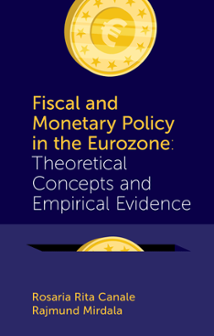Fiscal and Monetary Policy in the Eurozone: Theoretical Concepts and Empirical Evidence

Synopsis
Table of contents
(9 chapters)Abstract
In this chapter, the historical and theoretical evolution of the policy framework in Europe is presented. It begins from the early steps guided by the general principles of the Keynesian theory in open economies, goes through its revision after the 1970s and the fall of the Bretton Woods agreements, the creation of the European monetary system, and ends with a presentation of the theoretical underpinning that brought to the model on which the European monetary union was built on. The evolution of the economic theory is pieced together, in the light of the main historical and political facts that occurred. A first insight about the flaws of the Eurozone policy framework is provided.
Abstract
This chapter is devoted to fiscal policy theory and to how its evolution influenced the policy principles implemented from the end of the World War II to the present. It shows how the theoretical foundations evolved, from the Keynesian theory according to which public expenditure was conceived as an instrument to sustain aggregate demand and achieve full employment, to the present theoretical framework in which, following the intertemporal approach, it has been downgraded to an external shock. The public debt issue is examined with the aim of explaining why sound public finance represents a primary policy objective in the Eurozone.
Abstract
The role of money and monetary policy of the central bank in pursuing macroeconomic stability has significantly changed over the period since the end of World War II. Globalization, liberalization, integration, and transition processes generally shaped the crucial milestones of the macroeconomic development and substantial features of economic policy and its framework in Europe. Policy-driven changes together with variety of exogenous shocks significantly affected the key features of macroeconomic environment on the European continent that fashioned the framework and design of monetary policies.
This chapter examines the key basis of the central bank’s monetary policy on its way to pursue and preserve the internal and external stability of the purchasing power of money. Substantial elements of the monetary policy like objectives and strategies are not only generally introduced but also critically discussed according to their accuracy, suitability, and reliability in the changing macroeconomic conditions. Brief overview of the Eurozone common monetary policy milestones and the past Eastern bloc countries’ experience with a variety of exchange rate regimes provides interesting empirical evidence on origins and implications of vital changes in the monetary policy conduction in Europe and the Eurozone.
Abstract
This chapter examines the issue of policy coordination as conceived by the Eurozone institutional setting. After having briefly recalled the meaning of fiscal and monetary policy coordination in the Keynesian and present paradigm, it describes the meaning of coordination inside the Eurozone: it emerges as a marked subordination of national fiscal policies to the objective of the stability of the common currency, in term of prices and interest rates. This feature generates two main fragilities to which the entire Euro Area is exposed: the first deriving from the role assigned to financial markets and the second one linked to the presence of external imbalances. Some reflections about the need to build up common policy institutions as a mean to grant stability and growth in the Eurozone are provided.

- DOI
- 10.1108/9781787437937
- Publication date
- 2019-05-13
-
- ISBN
- 978-1-78754-126-9
- eISBN
- 978-1-78743-793-7